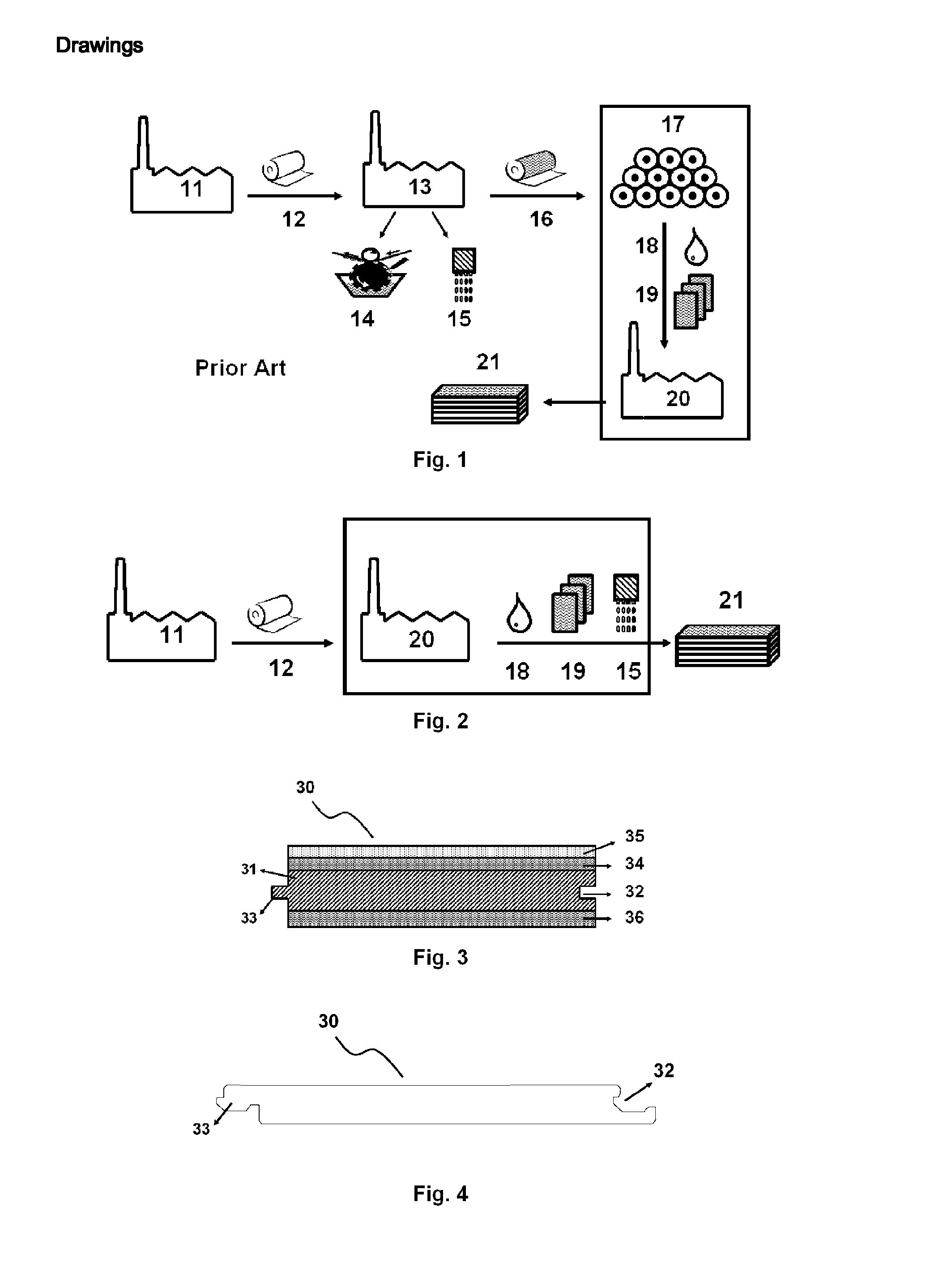Inkjet printing methods for manufacturing of decorative surfaces
a printing method and decorative surface technology, applied in the direction of printing, duplicating/marking methods, inks, etc., can solve the problems of observed adhesion problems and blister formation, etc., to achieve the effect of minimizing dependence on supply, facilitating production, and facilitating production
- Summary
- Abstract
- Description
- Claims
- Application Information
AI Technical Summary
Benefits of technology
Problems solved by technology
Method used
Image
Examples
example 1
[0256]This example illustrates an aqueous inkjet ink set which is suitable for printing colour patterns for flooring laminates and which also has sufficient reliability for industrial inkjet ink printing.
Preparation of Inkjet Inks
[0257]Each of the inkjet inks was prepared in the same manner by diluting a concentrated pigment dispersion with the other ink ingredients.
[0258]The concentrated aqueous pigment dispersion was made in the same manner for each colour pigment by mixing a composition according to Table 4 for 30 minutes using a Disperlux™ Yellow mixer.
TABLE 4ComponentConcentration (wt %)Pigment15.00Edaplan15.00Proxel 0.02Waterto complete 100.00 wt %
[0259]Each concentrated aqueous pigment dispersion was then milled using a Dynomill™ KDL with 0.04 mm yttrium stabilized zirconium beads YTZTM Grinding Media (available from TOSOH Corp.). The mill was filled to half its volume with the grinding beads and the dispersion was milled for 3 hours at flow rate of 200 mL / min and a rotation ...
example 2
[0275]This example illustrates the manufacturing of a decorative surface using an inkjet printing method.
Manufacturing of Decorative Surface
[0276]An 80 g / m2 porous paper used for decor printing was impregnated with an aqueous solution containing 60 wt % of melamine-formaldehyde based resin and dried before inkjet printing to a residual humidity of about 8 g / m2.
[0277]A decorative layer was obtained by printing a decorative pattern on the melamine-formaldehyde based resin impregnated paper using ink from the CRYK inkjet ink set in Table 7 and a KJ4B Kyocera print head at a head temperature of 32° C. at 600 dpi. The dry weight of the jetted ink was less than 1 g / m2.
[0278]An assembly was made as shown in FIG. 3, wherein the prepared decorative layer was interposed between a HDF core and protective layer of unprinted melamine-formaldehyde resin impregnated paper containing aluminium oxide for durability. The assembly was then heat pressed into a laminate by a DPL process using 138 bar an...
example 3
[0282]This example illustrates the advantageous effects on image quality by the addition of a polymer latex binder to one or more of the aqueous inkjet inks, as required by the present invention, while maintaining good results on adhesion and blister formation.
Preparation of Inkjet Inks
[0283]A first aqueous inkjet ink set S1 was prepared by using the same concentrated pigment dispersions of Example 1 and mixing the components according to Table 16.
TABLE 15Component (in wt %) in S1CRYKPB15:3-concentrated dispersion20.0———PR254-concentrated dispersion—20.0——PY151-concentrated dispersion——20.0—PBL7-concentrated dispersion———20.0Capstone ™ FS31000.70.70.70.7Emuldur ™ 381A30.030.030.030.0Water29.329.329.329.32-Pyrrolidone20.020.020.020.0Viscosity (mPa · s) at 32° C.3.43.94.35.3Surface Tension (mN / m)20.720.319.519.3
[0284]A second aqueous inkjet ink set S2 was prepared by mixing the components according to Table 17.
TABLE 16Component (in wt %) in S2CRYKCab-O-jet ™ 450C20.0———Cab-O-jet ™ 465...
PUM
| Property | Measurement | Unit |
|---|---|---|
| temperature | aaaaa | aaaaa |
| viscosity | aaaaa | aaaaa |
| viscosity | aaaaa | aaaaa |
Abstract
Description
Claims
Application Information
 Login to View More
Login to View More - R&D
- Intellectual Property
- Life Sciences
- Materials
- Tech Scout
- Unparalleled Data Quality
- Higher Quality Content
- 60% Fewer Hallucinations
Browse by: Latest US Patents, China's latest patents, Technical Efficacy Thesaurus, Application Domain, Technology Topic, Popular Technical Reports.
© 2025 PatSnap. All rights reserved.Legal|Privacy policy|Modern Slavery Act Transparency Statement|Sitemap|About US| Contact US: help@patsnap.com



